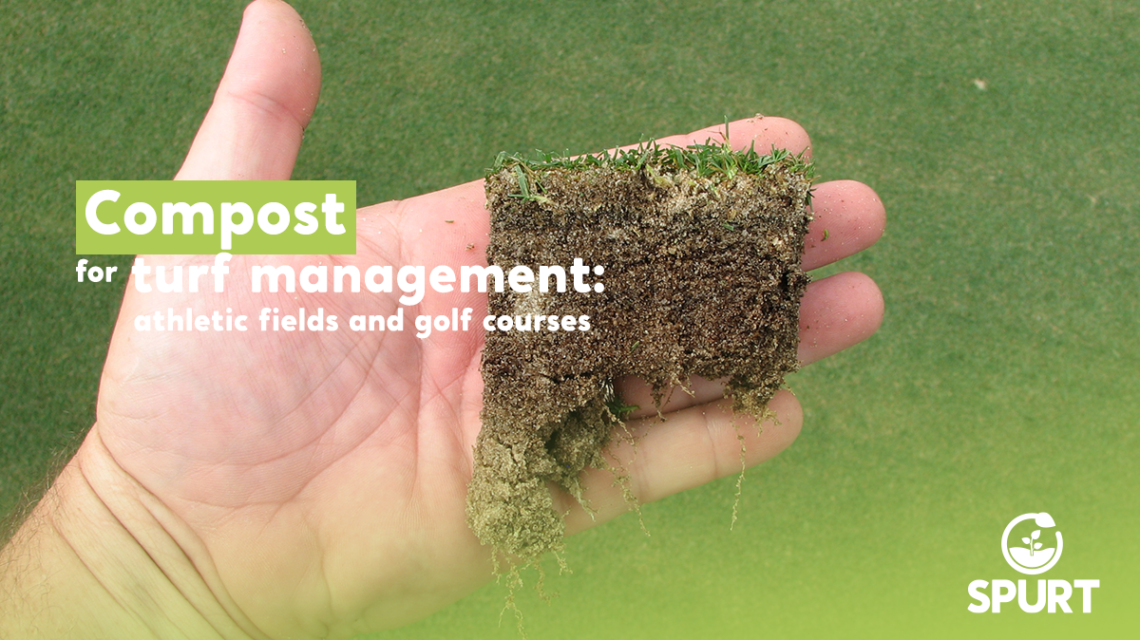Sports facilities and golf courses around the country are using compost to improve the quality of their soil. One of the keys to establishing a successful field/golf course is the selection of a good quality soil for the root zone; however, most of these sport fields are currently constructed on native type soils, which may contain clay or sand to a degree that affects the ability to grow and sustain quality turfgrass.
Compost and compost-based products can be a significant source of essential plant nutrients such as nitrogen, phosphorus, potassium, calcium, magnesium, and sulfur, as well as micronutrients such as zinc, iron, copper and manganese. However, the nutrient concentrations can vary widely from one compost to another. To determine appropriate compost, it is important to get STA Certified Compost, to learn about nutrient content, organic matter content and other parameters that are part of this information disclosure program.
Two primary methods of adding organic matter to sports fields and golf courses are turf establishment and topdressing. Incorporating compost during turf establishment is the most effective method to improve poor quality soils as it provides direct improvement in soil structure, porosity, and infiltration rates. Once turfgrass is established, adding significant amounts of organic matter to the soil becomes an annual practice. Applications of organic matter can be made once or twice a year, depending on the composition and quality of the soil.
For all types of turf establishment methods including seeding, sprigging, sodding, and hydroseeding, using compost has significant benefits:
- Enhances the rate of establishment and overall appearance,
- Nutrient savings – up to 50 – 100% of fertilization for the first year (some compost may supply 75% of the N & P for 2 years of turf growth),
- Water savings – 25 – 50% annually,
- May reduce or eliminate lime/gypsum application,
- Improves storm water capture, and
- May provide soil-borne disease suppression, reducing pesticide applications
Application:
- Incorporate uniformly to a depth of 6 inches using a rotary tiller or other appropriate equipment. Avoid incorporation when soils are excessively wet or dry.
- Pre-plant fertilizer and pH adjusting agents (e.g., lime and sulfur) may be applied in conjunction with compost incorporation, as necessary, but reduced nitrogen and phosphate application is suggested.
- Rake soil surface smooth prior to seeding, sprigging, sodding, or hydroseeding.
- The soil surface should be reasonably free of large clods, roots, stones greater than 2 inches, and other material which will interfere with planting and subsequent site maintenance.
- Where necessary, top-dress newly seeded and sprigged turf areas with a 1/4-inch layer of fine compost, then water to protect against hot, dry weather or drying winds. Use as a substitute for straw/hay or burlap cover.
- Water thoroughly after seeding, sprigging, or sodding.
If you top dress existing turf, the benefits of incorporating compost include:
- Nutrient savings – 50% or more of fertilization for the first year,
- Water savings – may be significant with multiple compost applications, or when done along with core aeration,
- Reduces soil compaction when completed along with aerification,
- Assists in the degradation of thatch,
- Enhances the rate of establishment and overall appearance, and
- May provide soil-borne disease suppression, reducing pesticide applications.
Application:
- Mow grass to preferred mowing height or slightly lower.
- Core-aerate the entire area to be treated with compost. Ideally, use deep (4 to 6 inch long, 1/2 inch wide, minimum), hollow tines for best results. Larger holes will more easily allow for compost to be backfilled into them.
- Uniformly apply approximately 1/4 to 1/2–inch of compost across the turf area to be treated.
- Back drag the entire area with a weighted chain-link fence, rake, or specialized implement, to break up the cores and blend them with the compost to fill in the aerification holes.
- Overseeding may be completed before or after the compost is applied. If done after top dressing, then rake the seed into the compost layer to cover it.
- Water the treated area well.


